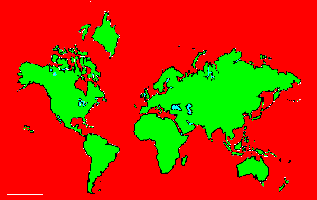SPECIES INFO
Smooth hammerhead shark (Sphyrna zygaena) is found almost worldwide. Per Schwartz, this is found from Nova Scotia to northern Argentina including the Gulf of Mexico and the Caribbean in the western Atlantic Ocean. However, this shark has a strong preference for coastal shelves, and is not common in the open sea. The dorsal and pectoral fins are long and pointed. This shark can grow to over 15 feet in length.
This shark is pictured in Kuiter's Coastal Fishes of SE Australia. One of those images shows a very large eye. There is a colored drawing of this shark on page 18 of the Diamond Hanbook of fishes of Britain and Europe by Nichols and Miller.Sphyrna genus, Hammerhead, contains seven species of sharks. The sharks in this genus have a very wide head. It is suggested that by placing the eyes and other sensors further apart, these species can triangulate with better success. Included in this genus is the great hammerhead (Sphyrna mokarran) which can reach 20 feet in length, but lengths of about 15-16 feet are more common.
Hammerhead Sharks (Family Sphyrnidae) are a group of marine sharks that prefer warmer waters. The unusual head shape of the Hammerheads has side lobes where the eyes are mounted. There are eight living species of Hammerheads. The following species are typical of the family:
Scalloped Hammerhead - Sphyrna lewini - Worldwide
Great Hammerhead - Sphyrna mokarran - Worldwide
Bonnethead - Sphyrna tiburo - Atlantic & Pacific
Smalleye Hammerhead - Sphyrna tudes - Atlantic & Pacific
Smooth Hammerhead - Sphyrna zygaena - Worldwide
Scalloped Hammerheads can be found as far north as New Jersey; the Great Hammerhead as far north as the Carolinas; the Bonnethead as far north as New England; the Smalleye into the Gulf of Mexico, and the Smooth Hammerhead as far north as New England.
This large order contains the catsharks, the houndsharks, the requiem sharks, and the hammerhead sharks. This large order contains about 225 species divided into about 8 families.
Sharks and rays (Elasmobranchi), cartilaginous fishes, deserve to be a class separate from the normal fish, in that they do not have a bone skeleton but rather a cartilage skeleton.
Fertilization is internal in this class which also separates them from the bony fish class. Although there are a few fresh water species, the majority of the species in this class are found in salt water. As of 2005, there were about 500 known species of sharks and about 600 known species of rays.
David Ebert, author of a recent book on sharks, rays, and chimaeras of California, counts a total of 988 described species in the class with about 150 additional species awaiting scientific description. He breaks down the described species to 410 species of sharks, 543 species of rays, and 35 species of chimaeras.
Many species of sharks face an uncertain future, as the Chinese purchase shark fins to make shark fin soup. It was estimated that 100 milllion sharks are killed each year for this purpose. However, recent estimates indicate the Chinese are reducing their consumption of this exotic soup.
Backboned Animals (Phylum Chordata) are the most advanced group of animals on earth. These animals are characterized by having a spinal cord or backbone. Most members have a clearly defined brain that controls the organism through a spinal cord. Fish, amphibians, reptiles, birds, and mammals are in this phylum.
Currently, some taxonomists believe that the fish should be divided into two groups (sharks and regular fishes) and that there are some other primitive groups in the phylum such as hagfish or lampreys.
Animal Kingdom contains numerous organisms that feed on other animals or plants. Included in the animal kingdom are the lower marine invertebrates such as sponges and corals, the jointed legged animals such as insects and spiders, and the backboned animals such as fish, amphibians, reptiles, birds, and mammals.

